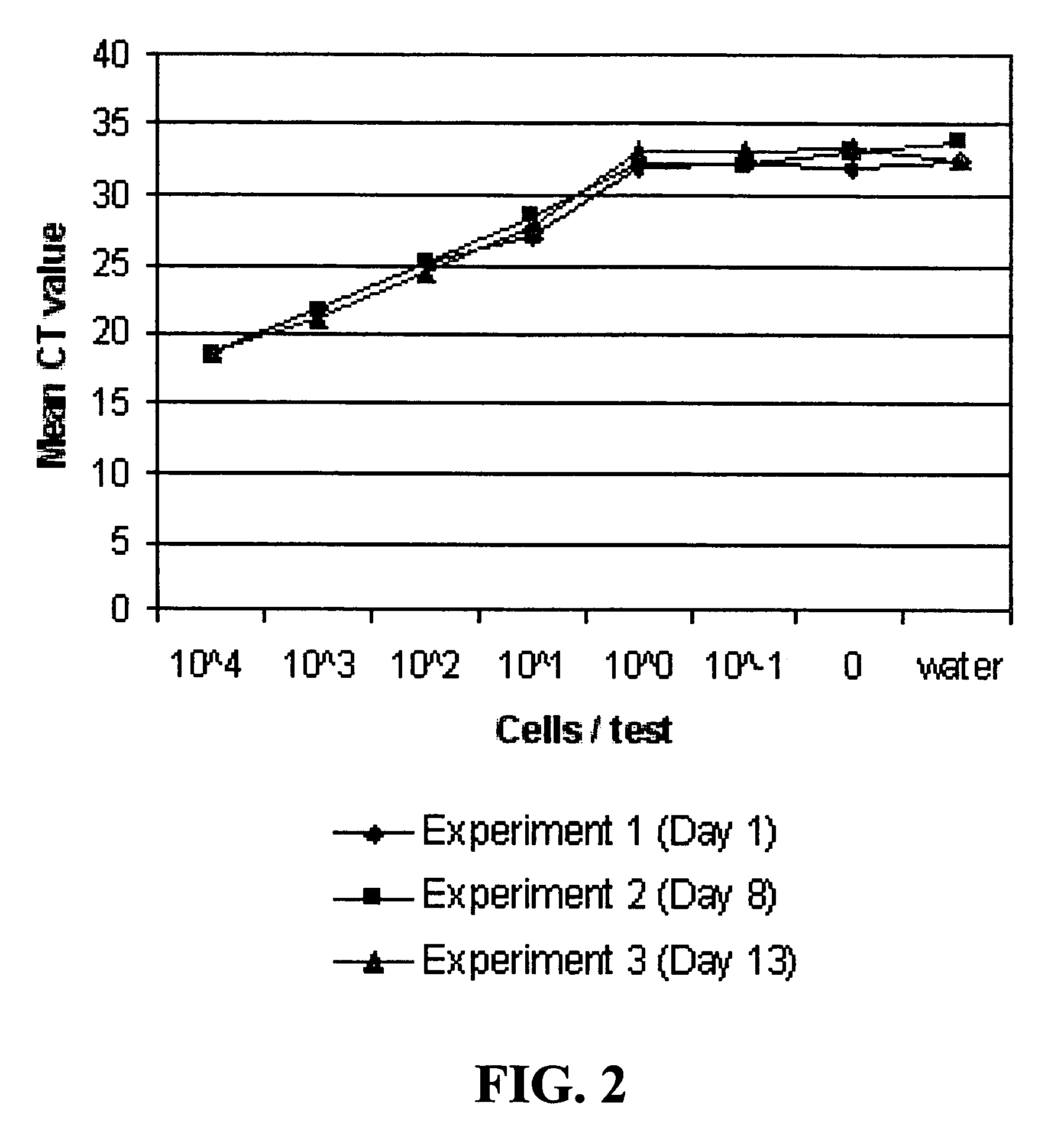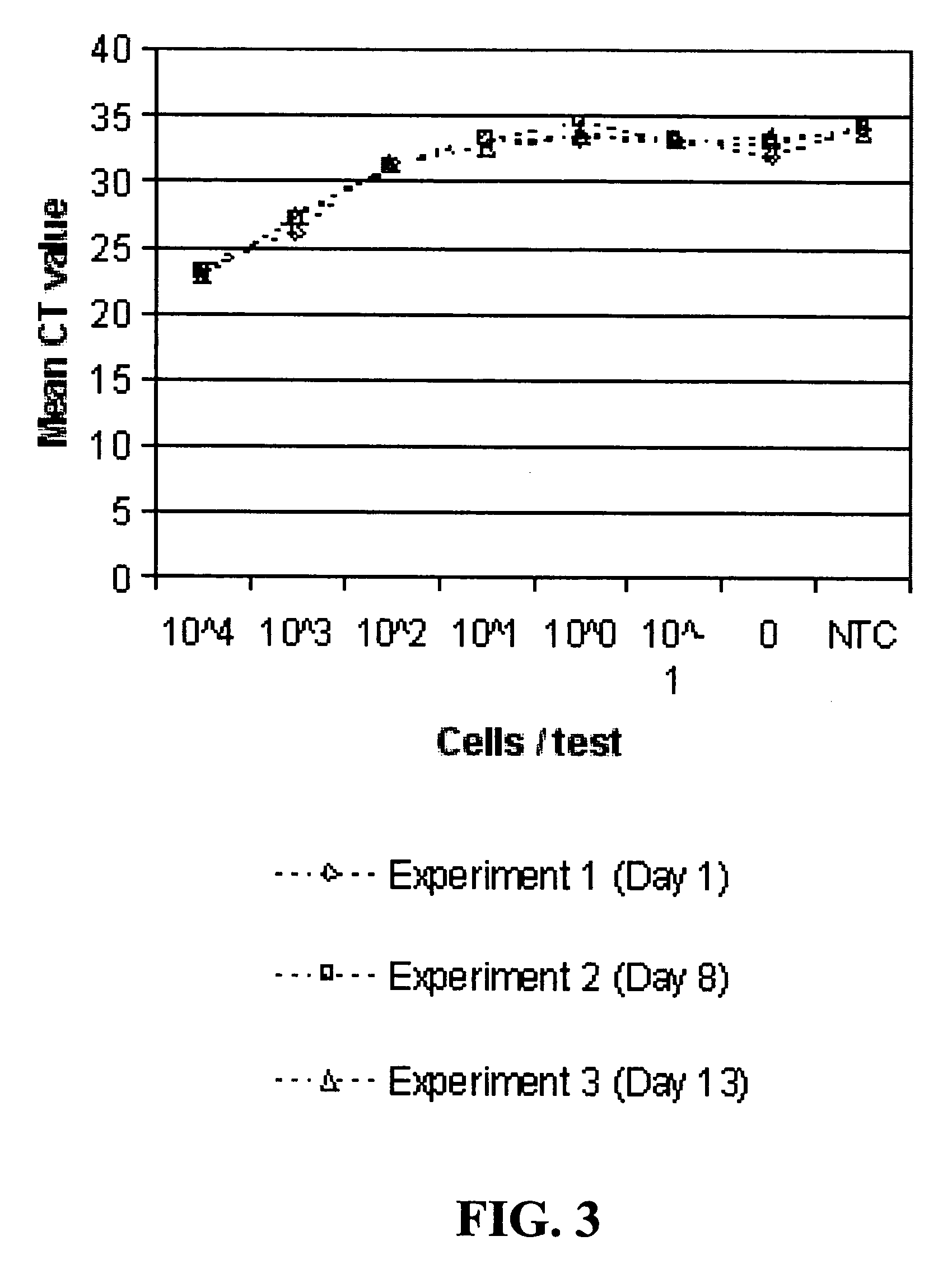Method for the direct detection of diagnostic RNA
a technology for diagnosing microorganisms and rna, which is applied in the field of direct detection of diagnostic rna, can solve the problems of time-consuming bacterial growth and rna preparation steps, lack of simplification of rna preparation process, and need for multi-step purification process, so as to improve the availability of rna
- Summary
- Abstract
- Description
- Claims
- Application Information
AI Technical Summary
Benefits of technology
Problems solved by technology
Method used
Image
Examples
example 1
Listeria innocua Cell Culture and cfu Determination
[0100]Listeria innocua (Strain CLIP 11262) was obtained from the American Type Culture Collection (ATCC #BM-680, Manassas, Va.). The Listeria innocua was hydrated with BHI culture medium. Cultures of Listeria innocua were spread and grown at 35° C. on TSA, then stored at 4° C.
[0101]A colony of Listeria innocua was removed from the TSA plate and placed in TSB. The tube containing the TSB was placed in the Incubator Shaker (Model G24, New Brunswick Scientific, Edison, N.J.) at 31° C. for 18 hours. For estimates of cell number, 1 mL of this culture was removed and placed in the Beckman DU-7500 Spectrophotometer (Beckman Coulter, Fullerton, Calif.). Absorbance was used to approximate cell concentration and was read at 600 nm. An absorbance of 1.0 was used as a reference and indicated approximately 1.0×109 cells / mL.
[0102]To determine cell number in stock solutions, diluted cell samples were prepared by transferring another 1 mL of the cu...
example 2
Detection of 16S rRNA Target Directly in Whole Cell Samples of Listeria innocua using Real Time RT-PCR
[0103]In this example, a single step RT-PCR assay for the Listeria innocua 16S rRNA target sequence was performed on the bacterial cells with no prior lysis step.
[0104]An overnight culture of Listeria innocua cells (3.6×108 cfus / mL) was prepared and diluted as indicated in Example 1. To prepare samples of cells for testing, 1 mL aliquots from the 1:1000 to 1:1000000000 dilutions were placed in Eppendorf Biopur tubes (Brinkmann Eppendorf, Westbury, N.Y., Catalog #22 60 004-4) that were then centrifuged on high (13,200 rpm) for 10 min in an Eppendorf 5415D Centrifuge (Brinkmann Eppendorf, Westbury, N.Y.). The phosphate buffer was removed from the samples.
[0105]A cell diluent was prepared by adding 5 μL RNase Inhibitor (100 U) to 45 μL of DEPC treated water. This 50 μL solution was added to each of the Biopur tubes containing a Listeria innocua cell pellet. Each tube was vortexed on a ...
example 3
Reproducibility of 16S rRNA Target Detection in Whole Cell Samples of Listeria innocua using Real Time RT-PCR
[0133]Listeria innocua cultures were grown overnight and processed as in Example 1. Cell samples were tested under the same exact conditions as in Example 2, in two additional experiments (different days).
[0134]Plots of the CT values for the RT-PCR and PCR reactions from experiments run on Day 1, 8 and 13 are shown in FIGS. 2 and 3. The number of cells per reaction from experiments run on Day 1 ranged from 3.6×104 to 3.6×10−1, 3.2×104 to 3.2×101 on Day 8, and 7.5×104 to 7.5×10−1 on Day 13. The plots show that the CT values were closely reproduced among the different experiments. The derivative peak data for the same reactions are shown in FIGS. 4 and 5. The plots of these data also showed that the data were reproduced. Both types of data indicated that RNA was directly detectable from Listeria bacterial cells without RNA extraction or prior cell lysis.
PUM
| Property | Measurement | Unit |
|---|---|---|
| temperature | aaaaa | aaaaa |
| temperature | aaaaa | aaaaa |
| temperature | aaaaa | aaaaa |
Abstract
Description
Claims
Application Information
 Login to View More
Login to View More - R&D
- Intellectual Property
- Life Sciences
- Materials
- Tech Scout
- Unparalleled Data Quality
- Higher Quality Content
- 60% Fewer Hallucinations
Browse by: Latest US Patents, China's latest patents, Technical Efficacy Thesaurus, Application Domain, Technology Topic, Popular Technical Reports.
© 2025 PatSnap. All rights reserved.Legal|Privacy policy|Modern Slavery Act Transparency Statement|Sitemap|About US| Contact US: help@patsnap.com



